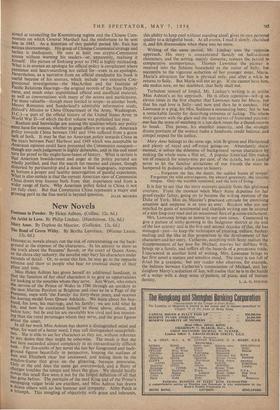New Novels
Footman in Powder. By Helen Ashton. (Collins. 12s. 6d.) HISTORICAL novels always run the risk of concentrating on the back- ground at the expense of the characters. In his anxiety to show us the truth about the Peasants' Revolt, or the court of Queen Anne, or the china clay industry, the novelist may bury his characters under mounds of detail. Or, to avoid this fate, he may go to the opposite extreme and show us people who bear no essential stamp of their Place and time.
Miss Helen Ashton has given herself an additional handicap, in that the function of her chief characters is to give us opportunities for looking at the notables whom they serve. Jem Wyett, who enters the service of the Prince of Wales in 1786 -through an accident to the new Marine Pavilion at Brighton and rises to be a Page of the Presence, stays with 'the Family' for forty-three years, and receives his.leaving medal from Queen Adelaide. We learn about his boy- hood, his love, his marrrage, and his family; we are told what he felt, and how he conducted himself to those above, about, and below him; but he and his arc inevitably less vivid and less interest- ing than the royal personages whom they serve, and the great figures about the court. this ability to keep cool without standing aloof, gives its rare personal quality to a delightful book. At.all events, I read it slowly, cherished it, and felt disconsolate when there was no more.
Writing of the same period, Mr. Lindsay uses the opposite approach. His story is concentrated fiercely on half-a-dozen characters, and the setting, mainly domestic, reduces the period to comparative unimportance. Thomas Lawrence the painter is received into the Siddons household as the suitor of Sally, but succumbs to the vigorous seduction of her younger sister, Maria. Maria's attraction for him is physical only, and after a wh.le he returns to Sally. But Maria will not let go. if she cannot have him, she makes sure, on her deathbed, that Sally shall not.
Turbulent instead of limpid, Mr. Lindsay's writing is as unlike Miss Ashton's as his approach. He is often repetitive—tell! g us eleven times in the first chapter that Lawrence lusts for Maria, but that his real love is Sally—and now and then he is careless. His Lawrence is a prig, his Mrs. Siddons a resounding bore; but he has a remarkable faculty for describing extremes of feeling. The whole story quivers with the glare and the taut nerves of frustrated passion: one has the sense of watching in a hot dark room for a thunderstorm to break. This power, his manifest sincerity, and the .strongly drawn portraits of the women make a handsome credit balance, and compel respect for the author.
Mary Anne belongs to the same age, with Brighton and Hampstead and plenty of royal and off-royal goings-on. Abundantly docu- mented, it solves the dilemma of background versus characters by making the whole scene a film set. A popular historical film makes use of research for ninety-nine per cent. of the details, but is careful never to let -the familiar attractions of our friends the stars be hampered by pedantic adherence to history.
. Forgotten the lies, the deceit, the sudden bursts of temper. Forgotten the wild extravagance, the absurd generosity, the vitriolic tongue. Only the warmth remained, and the love of living.
It is fair to say that the story recovers quickly from this glutinous overture. From the moment when Mary Anne deputises for her proof-reader father,, going on to become the willing mistress of the Duke of York, Miss du Maurier's practised aptitude for contriving situation and suspense is as sure as ever. Readers who are not repelled by gusts of sentimental and slapdash writing can be assured of a nice long cosy read and an occasional flare of genuine excitement.
Mrs. Lawrence brings us nearer to our own times. Concerned to give a picture of withy-growing in the Sedgmoor district at the end of the last century and in the first and second decades of this, she has managed—just—to keep the techniques of planting, culture, basket-, making and the like in due proportion to the development of her characters and her story. Catherine, accepting with fierce realism the disappointment of her love for Michael, marries her shiftless Will, brings up a family, and suffers all the hazards of a precarious trade. Experienced in another kind of writing, Mrs. Lawrence brings to her first novel a mature and sensitive mind. The story is too full of detail for a synopsis; but any reader who observes, for example, the balance between Catherine's renunciation of Michael, and her daughter Marty's seduction of Jan, will realise that he is in the hands of a writer with a deep sense of pattern, of place, and of human destiny. L. A. G. STRONG










































 Previous page
Previous page